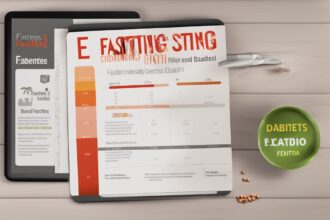Living with diabetes can feel like a constant balancing act—monitoring blood sugar, managing diet, and staying active. If you’re exploring alternative approaches to diabetes management, you might have come across the concept of fasting for diabetes. fasting, particularly intermittent fasting, has gained attention for its potential to improve insulin sensitivity and support overall metabolic health. But is it safe for people with diabetes? How does it work, and what precautions should you take? In this comprehensive guide, we’ll dive into the science behind fasting and diabetes control, share practical tips for incorporating fasting into your routine, and help you decide if this approach is right for you. Let’s explore how fasting might become a powerful tool in your diabetes management toolkit.
What Is fasting, and How Does It Relate to Diabetes?
Fasting is the practice of abstaining from food and, in some cases, drink for a specific period. It’s been used for centuries across cultures for spiritual, health, and wellness reasons. Today, forms like intermittent fasting (IF)—where you cycle between eating and fasting periods—have become popular for weight loss and metabolic health. For those with diabetes, particularly type 2, fasting for diabetes management is being studied for its ability to lower blood sugar levels, reduce insulin resistance, and promote weight loss, which are all critical factors in controlling the condition. When you fast, your body switches from using glucose as its primary energy source to burning stored fat, a process called ketosis. This shift can help stabilize blood sugar spikes and improve how your body responds to insulin over time.
The Science Behind Fasting for Diabetes Control
Research into fasting and blood sugar control is still evolving, but early studies are promising. A 2018 study published in the journal Obesity found that intermittent fasting helped participants with type 2 diabetes lose weight and improve insulin sensitivity. Another study in Cell Metabolism (2017) suggested that fasting-mimicking diets could even regenerate pancreatic cells, potentially aiding insulin production. During fasting, the body’s insulin levels drop, giving cells a break from constant glucose processing. This “rest” can reduce inflammation and oxidative stress, both of which contribute to diabetes complications. However, it’s crucial to note that fasting isn’t a one-size-fits-all solution—results vary based on individual health, diabetes type, and medication use. Always consult a healthcare provider before starting any fasting regimen for diabetes management.
Benefits of Fasting for People with Diabetes
Integrating fasting for diabetes into your lifestyle can offer several potential benefits if done correctly. Here are some of the key advantages supported by emerging research and anecdotal evidence:
- Improved Insulin Sensitivity: Fasting can help your cells become more responsive to insulin, reducing resistance over time.
- Blood Sugar Regulation: By limiting food intake windows, fasting may prevent drastic glucose spikes after meals.
- Weight Management: Losing excess weight through fasting can significantly improve type 2 diabetes symptoms.
- Reduced Inflammation: Fasting has been linked to lower markers of inflammation, a key factor in diabetes progression.
- Enhanced Metabolic Health: Fasting can improve lipid profiles, lowering triglycerides and boosting overall heart health.
Potential Risks and Precautions to Consider
While intermittent fasting for diabetes shows promise, it’s not without risks, especially for those on medications like insulin or sulfonylureas. Fasting can lead to hypoglycemia (low blood sugar), dehydration, or even diabetic ketoacidosis in rare cases if not managed properly. People with type 1 diabetes, pregnant women, or those with a history of eating disorders should approach fasting with extreme caution or avoid it altogether. Always work with a doctor or dietitian to tailor a fasting plan to your needs. Monitor blood sugar levels frequently during fasting periods, and break the fast immediately if you feel dizzy, weak, or unwell. Safety must come first when exploring fasting and diabetes management.
Practical Tips for Starting Fasting with Diabetes
If you’ve got the green light from your healthcare team to try fasting for diabetes, starting small and staying consistent is key. Fasting doesn’t have to be extreme—there are various methods like the 16:8 (fast for 16 hours, eat during an 8-hour window) or 5:2 (eat normally for 5 days, restrict calories on 2 days) that can ease you into the practice. Here are some actionable tips to help you fast safely and effectively:
- Start Gradually: Begin with shorter fasting windows, like 12 hours overnight, before progressing to longer periods.
- Stay Hydrated: Drink plenty of water during fasting hours to avoid dehydration, a common concern for diabetics.
- Choose Nutrient-Dense Meals: Break your fast with balanced meals rich in fiber, protein, and healthy fats to stabilize blood sugar.
- Monitor Blood Sugar Closely: Check levels before, during, and after fasting to catch any irregularities early.
How to Combine Fasting with a Diabetes-Friendly Diet
Fasting alone isn’t a magic bullet for diabetes control—it works best when paired with a thoughtful, diabetes-friendly diet during fasting. Focus on low-glycemic foods that don’t cause rapid blood sugar spikes when you eat. Think whole grains, leafy greens, lean proteins, and healthy fats like avocado or nuts. Avoid refined sugars and processed carbs, which can undo the benefits of fasting. Timing matters too—breaking your fast with a small, balanced meal can prevent overeating and keep glucose levels steady. Consider working with a nutritionist to create a meal plan that complements your fasting schedule and supports long-term diabetes management through fasting. Remember, consistency in both fasting and diet is what drives lasting results.
In conclusion, fasting for diabetes offers a promising avenue for managing blood sugar, improving insulin sensitivity, and supporting overall health—but it’s not a standalone cure. When approached with caution and under medical supervision, fasting can be a valuable addition to your diabetes management strategy. Whether you’re curious about intermittent fasting or simply looking for new ways to take control of your health, start small, stay informed, and prioritize safety. Have you considered fasting as part of your diabetes journey? Share your thoughts or experiences below—we’d love to hear how this approach has worked for you or what questions you still have. Let’s keep the conversation going and support each other in living healthier, fuller lives with diabetes.






